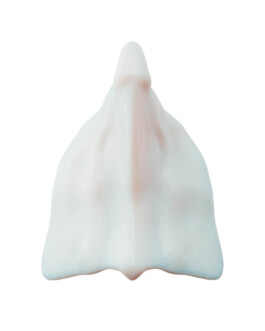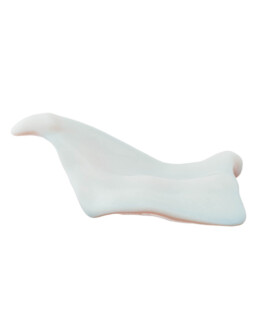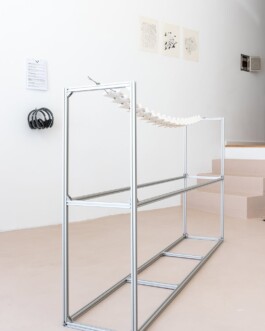25022025
SCULPTURE
SLA PRINT
SD CARD
ALUMINIUM
CONTACT MICROPHONE


Amid the never-ending human-made acoustic sources, there are parts of the sonic world that will inevitably be lost. Traffic noise, construction sites, industrial sound pollution – our soundscape is shaped by the Anthropocene. We leave busy cities for a short trip to relax while forest bathing or use artificial nature sounds to help us concentrate. With advanced technologies such as wireless in-ear headphones that are easy to use in our everyday lives, constant background music, podcasts or noise-canceling eliminate the sounds of our outside world. So, what do we even register at the audible level? What is our sonic truth (or sooth)? Which sounds of the more-than-human sphere are we obscuring, repressing or have we already erased?
This project investigates the acoustic potential of fish bone structures using a digitally reconstructed skeleton of a pike (Esox lucius), once a dominant species in the Danube-Caspian region. Based on high-resolution CT scan data, vertebral elements were 3D-printed via stereolithography (SLA) using a composite resin containing ceramic particles. The resulting structures were excited mechanically, and the generated sound waves were recorded using contact microphones. The project combines anatomical reconstruction, material science, and experimental sound design.
The digital core of the project – the interactive website sonicextinction.net – will be transformed into spatial experiences which challenge past, present and future scenarios on the topic of climate change and biodiversity decline through narration and sonic activism.
Founded in 2022 by Kalas Liebfried in the form of a digital platform, FOSE intends to shift the focus on ephemeral extinction and the complexity of the rapid changes within the sonic spheres of our world.
Many Thanks to Kalas Liebfried, Jol Thoms, Nebyula.space , Alexander Scharf and FOSE


25022025
SCULPTURE
SLA PRINT
SD CARD
ALUMINIUM
CONTACT MICROPHONE

Amid the never-ending human-made acoustic sources, there are parts of the sonic world that will inevitably be lost. Traffic noise, construction sites, industrial sound pollution – our soundscape is shaped by the Anthropocene. We leave busy cities for a short trip to relax while forest bathing or use artificial nature sounds to help us concentrate. With advanced technologies such as wireless in-ear headphones that are easy to use in our everyday lives, constant background music, podcasts or noise-canceling eliminate the sounds of our outside world. So, what do we even register at the audible level? What is our sonic truth (or sooth)? Which sounds of the more-than-human sphere are we obscuring, repressing or have we already erased?
This project investigates the acoustic potential of fish bone structures using a digitally reconstructed skeleton of a pike (Esox lucius), once a dominant species in the Danube-Caspian region. Based on high-resolution CT scan data, vertebral elements were 3D-printed via stereolithography (SLA) using a composite resin containing ceramic particles. The resulting structures were excited mechanically, and the generated sound waves were recorded using contact microphones. The project combines anatomical reconstruction, material science, and experimental sound design.
The digital core of the project – the interactive website sonicextinction.net – will be transformed into spatial experiences which challenge past, present and future scenarios on the topic of climate change and biodiversity decline through narration and sonic activism.
Founded in 2022 by Kalas Liebfried in the form of a digital platform, FOSE intends to shift the focus on ephemeral extinction and the complexity of the rapid changes within the sonic spheres of our world.
Many Thanks to Kalas Liebfried, Jol Thoms, Nebyula.space , Alexander Scharf and FOSE


POLICY + AGB + PORTFOLIO